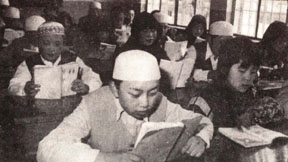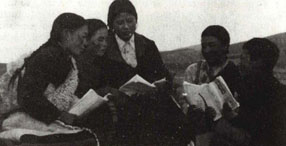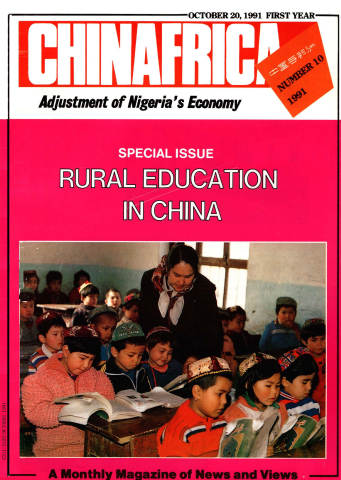China has a population of over 1.1 billion, of which 800 million live in rural areas. A nine-year compulsory education has been realized in the cities. Now the main task that confronts China is the realization of universal education in the countryside.
I. China’s rural education is of great importance and the development of rural construction calls for further reform of education.
The significance of rural education is closely related to that of agriculture for China’s economy. China’s modernization depends on the modernization of its countryside, which calls for the development of education. Agriculture not only concerns itself with feeding and clothing over 1.1 billion people, but also conditions the speed and scope of China’s economic construction and development as a whole. The Chinese government has always made agriculture the foundation of the national economy. In the past ten years of reform in particular, the Chinese farmers have manifested ever-growing enthusiasm for production to speed up the development of agriculture and rural economy. This makes it possible for China to feed 22 percent of the world’s population with 7 percent of the world’s total arable land.
China’s per-capita agricultural resources, however, are relatively insufficient. Its population keeps growing while per-capita arable land is decreasing. Heavy tasks lie ahead in the field of agriculture. In order to further raise the agricultural production and standards of living, the Chinese government has decided to implement policies based on sciences and technologies and develop in depth farming, forestry, animal husbandry and fishery. But this requires qualified personnel in large numbers. That is why the Chinese government lays great emphasis on “developing agriculture by means of science and technology.” Even more important is to improve the cultural and technical competence of the broad masses of farmers as well as of workers of township enterprises, and to increase their ability to absorb and make use of scientific knowledge and techniques.
Since New China’s birth in 1949, rural education has undergone tremendous development with large numbers of educated labourers trained for the countryside. In the early 1950s, China had only 289,000 primary schools and 5,892 secondary schools, most of them in the cities. Today, however, China has 749,000 primary schools, 78,000 secondary schools, over 9,100 vocational high schools, 250,000 primary schools for adults, and 4,100 secondary schools for adults. Student enrolment in rural schools of all types (adult schools included) reaches a total of 140 million.
But despite the great achievements made, there remain quite a few problems:
First, for a rather long period of time, many schools merely prepared students for higher school entrance, ignoring the needs for productive and technical know-how for the large number of primary and secondary school students who go home after graduation and engage in production.
Second, educational contents are comparatively unitary, priority being given to general basic cultural knowledge, and vocational and technical as well as adult education being comparatively weak. There is a lack of bases for the training of technical personnel needed in agricultural production and in township enterprises.
Third, the contents of school teaching fail to reflect the needs of rural construction, and lack in local features. Schools fail to form close links with local communities and the life of the masses.
The presence of all above problems has led to a shortage of specialized technical personnel and a lower technical level of labourers in rural areas. In order to make sure that all 800 million farmers live a decent life, measures have been taken to reform education in the rural areas.
II. Objectives of the reform of China’s rural education and measures to attain them.
China is confronted with the arduous task of literacy and universal education on a large scale. There are two big problems with regards to the development of rural education. One is a lack of funds and teachers; the other is how to couple education with the interests of the farmers, so that they support education and schools play an important part in economic life. Our basic experience in solving these problems so far can be summed up as: rely on the people to develop education and run education for the people.
To rely on the people to carry out the education serves as an important basis for the development and reform of China's rural education. In accordance with China’s actual conditions, funds for rural education mainly come from state financial allocations. In the meantime, funds are also raised through different channels. In the past ten years, the increase of funds for education from financial allocations from governments at various levels has exceeded that of state expenditure in the same period. The system of “schools run and administered at different levels” has been carried out across the country since 1985. Under the system, governments at various levels are put in charge of the development of primary and secondary education of all types in rural areas. In the past few years, more and more local governments have increased their input in education. The main part of a township government’s expenditure goes to education while the expenditure of most counties for education accounts for over 30 percent. In the meantime, the public is called on to raise funds or donate money to run schools. Educational foundations are established and an additional education tax is levied. As a result, the shortage of funds for education has been covered to some extent and the conditions of schools of various types in rural areas have remarkably improved.
To run schools for the benefit of the people means that education should bring welfare to the farmers. This is the destination point as well as the starting point of the development and reform of China’s rural education. Therefore, the Chinese government pointed out in the early 1980s that the task of rural schools is to raise the cultural and scientific level of the new generation as well as of the broad masses of rural labourers; to promote rural construction; and to satisfy the farmers, demands for increased production and income, and for technical personnel. In 1987, the State Education Commission started an experiment on the reform of rural education, first in Hebei Province, and later throughout the country. Its chief objectives and measures are as follows:
(1) To change views on education. The purpose of rural education should be turned from merely preparing students for a higher grade or a higher school to mainly training technical personnel for the localities while taking care of the students' continuing education. Schools should concern themselves with local economic development, strengthen their relationship with the communities, and participate in social change. They should also educate students to love the countryside and labour, to learn about culture and techniques well, and to be determined to develop their native places.
(2) To improve educational contents. In the process of strengthening basic education, great efforts should be made to develop vocational and technical education and adult education of various levels and forms, so as to develop two parallel series of ordinary primary education on the one hand and specialized technical education of various types on the other. The two should be closely connected so as to train and bring up a new generation of farm labourers who have acquired both a good cultural knowledge and a proper mastery of certain specialized techniques.
(3) To co-ordinate the relationship among schools of the three types.
First of all, primary education should be well carried on, as it serves as the basis for all types of education and for the improvement of the nation’s qualifications. To this end, efforts are put into raising the competence of teachers, further improve school conditions, and supplement schools with more tools and equipment as well as books and reference materials, so as to help them fulfill the requirements for the standardization set forward by the state. At present, there are elementary schools in all the larger villages, key elementary schools and junior high schools in every township, and senior high schools in every county. In the pastoral and mountainous areas which are sparsely inhabited by ethnic minorities or nomads, boarding schools were set up. All this ensures the steady and gradual implementation of the nine-year compulsary education programme. In order to enhance the relationship between education and the production and life of the local people, elementary and high schools in rural China have introduced, in accordance with local conditions, some contents of vocational and technical education. The government has allocated land for use as bases on which students engage in productive labour. Attention is paid to the combination of various courses with practice, and extracurricular scientific and technical activities are actively carried out. As for the primary and secondary school graduates who fail to go on to a higher school, they are given a certain period of training during which they are taught one or two practical skills. In some cases, students entering their third year in junior high school are streamed into two groups: some go into the group that lays stress on the study of vocational and technical courses to prepare for employment; the other group continues the regular curriculum to enter a higher school. Some schools adopt a four-year schooling, devoting 20 percent of the total class hours to vocational and technical courses taught throughout the four years in combination with cultural courses.
Second, the development of rural vocational and technical education requires that each county should set up a comprehensive key secondary vocational school which enrolls people with an education equal to that of a junior high school graduate. The school plays a versatile role in training, scientific experimentation, dissemination of techniques, management and service, etc.; it also maintains close links with institutions of higher learning and scientific research institutes concerned, works in close co-operation with local agricultural and scientific technological organs, and passes on practical technical knowledge. Generally, the length of schooling for such a vocational and technical school is three years and courses are based on the needs for rural construction. Most of the courses offered are agriculture related, covering a wider range of specialties in the service of farmers who want to improve their financial situation. It pays attention to the practicability of course content, giving prominence to the training in vocational skills so as to conscientiously train large numbers of intermediate technical personnel for rural areas who are highly adaptable.
Third, adult education in rural areas focuses on farmers who engage in productive labour or in-service staff and workers of township enterprises, as well as a small number of people who receive this type of education as part of a secondary or tertiary specialized school education. It offers a broad spectrum of subjects, from literacy classes to specialized technical education at various levels. One of its important tasks is to wipe out illiteracy among adults. Illiteracy among young and middle-aged people should be mainly eliminated by the end of this century. Literacy should also go hand in hand with the learning of cultural knowledge and technical skills. Adult education in rural areas is mainly carried on in cultural and technical schools at the village and township levels. Such schools are run in 60 percent or so of the townships and about 45 percent of the villages throughout the country. In some provinces the percentage is as high as 100 and over 70 percent respectively. In some counties, educational centres equipped with audio-visual equipment and satellite televisions have been set up for farmers. On the whole, technical training networks of various forms have taken shape at various levels.
(4) To reform the contents and methods of teaching, to train teachers, and to further increase the quality of education. Many provinces and counties have, in conformity with the actual situation in their localities, prepared supplementary textbooks and other teaching material which reflect local conditions and are suited to local needs. Through them, students get a knowledge of local culture, history, resources, population-growth control, environmental protection, economic development and other subjects that reflect the characteristics of their localities, while textbooks compiled by the State Education Commission are of universal use in rural schools at various levels. In the meantime, students are brought into contact with society at large and get their talents and abilities enhanced by taking part in practical extracurricular activities organized by schools. Educational TV stations have been set up and two TV channels via satellite broadcast educational programmes around the clock.
(5) To strengthen the links between the organs of education and those of agriculture, science and technology, so that they may combine their efforts and work in close co-operation for the development of agriculture. To this end, a co-ordination leading group has been formed under the leadership of the chief cadre of each province or county. This group’s work is to combine economic development with the formation of scientists, and the popularization of science and technology. At the township level, multiple-technical-service stations have been set up, to provide farmers with improved plant varieties, chemical fertilizers, pesticides, as well as technical consultation and short-term training in agronomy.
(6) To carry out the “Prairie-Fire Programme” (see P.48 of this issue) in a few selected localities before spreading the experience across the country. The development of different localities in China is uneven. Therefore, experiments were conducted in some selected localities. In recent years, there have emerged, one after another, a number of fine examples of educational reform in China’s rural areas. To profit from these experiences, the State Education Commission selected 116 counties out of the hundreds of counties that were carrying out the programme, and assigned them for experimentation on comprehensive reform in rural education. These counties are required to play an exemplary role in the fulfillment of the programme so that they can serve as examples to others across the country. At present, there are altogether 859 counties and 3,326 townships across the country that have started the programme.
III. Achievement in educational reform in rural China and the tasks that lie ahead.
Through ten years’ reform, education in China’s rural areas has promoted the development of rural economy, which, in turn, has further advanced the development and improvement of rural education.
(1) The practice of “running and administrating schools at different levels” has been universally adopted in rural areas, raised the public’s interest in school management, and improved the conditions of schools and the living conditions and welfare of teachers. Today, in rural areas the better houses are schoolhouses.
(2) Primary education has further developed and consolidated. The entrance rate of school-age children has reached over 95 percent. Primary education has been made universal in 76 percent of China’s counties. About 74.58 percent of the primary school graduates have entered junior high schools. Almost all of China’s counties and townships have realized universal junior high school education. Education for the blind, the deaf, the mute as well as the mentally retarded children has developed considerably. The proportion of children entering kindergarten has reached 90 percent in many rural areas.
(3) The development of vocational and technical education and adult education has been speeded up. Remarkable results have been achieved in the elimination of illiteracy. The proportion of illiterates reduced from over 80 percent in 1949 to 23.8 percent in 1982 and to 15.88 percent in 1990. The proportion of literates among people aged 15 to 40 has reached 91 percent. Student enrollment of vocational and technical senior high schools of various types accounts for 44.06 percent of the total number of students who are receiving senior high school education. In those counties which are implementing the “Prairie-Fire Programme,” elementary school graduates who attend short technical training classes of various kinds before returning to their native places amount to 56.1 percent of all the returned elementary school graduates; in the case of junior high school graduates, the percentage is 64.8; and, in the case of senior high school graduates, 64.5. Some 30 million farmers throughout the country receive technical training and a small number of localities have started the practice of granting farmer qualification certificates to trainees.
(4) In China’s rural areas where hundreds of millions of farmers live, the popularization of general conventional farming techniques has picked up. Such practical agrotechniques as cultivation of plants with plastic film covering, improved seeds, development of hybrid rice and corn, scientific management of orchards, and scientific livestock raising, have been mastered and put to use by more and more farmers. The ability of farmers to assimilate and apply scientific techniques as well as to manage and administrate has notably improved. This has resulted in the promotion of the development of rural economy and doubled the farmers’ annual per-capita income, as compared with that of ten years ago.
(5) The development of rural education has promoted healthy and civilized customs. Schooling years for farmers have increased, contributing to the universal implementation of family planning in rural areas. The population-growth rate has lowered remarkably, and the annual natural-growth rate has reduced to 14.7 percent. The use of biological energy and measures for the conservation of energy has been widely spread in rural areas, with benefits to the protection of the environment. Some old customs and habits prevailing in rural China are gradually giving way to a new way of life.
(6) Many universities and colleges as well as research institutes have sent teachers and research workers to rural areas to teach and spread new techniques, and to train local personnel. Widespread scientific techniques have brought impressive economic and social benefits. And it has also strengthened the links between institutions of higher learning and scientific research institutes and field practice.
In spite of the progress made in the educational reform in China’s countryside, the educational level in the rural areas is, on the whole, still comparatively low, the period of time for the experimentation of the reform is short, and the reform is still at its beginning. Furthermore, the reform has not developed in an even and well-balanced way due to the vastness and the marked differences of Chinese territory. Therefore, the tasks that lie ahead cannot but be arduous.

A Hui nationality high school in Qinghai Province. JIAO WEI

A Tibetan teacher (middle) and her students. JIAO WEI

Eliminating illiteracy at home. JIAO WEI


 Copy Reference
Copy Reference 